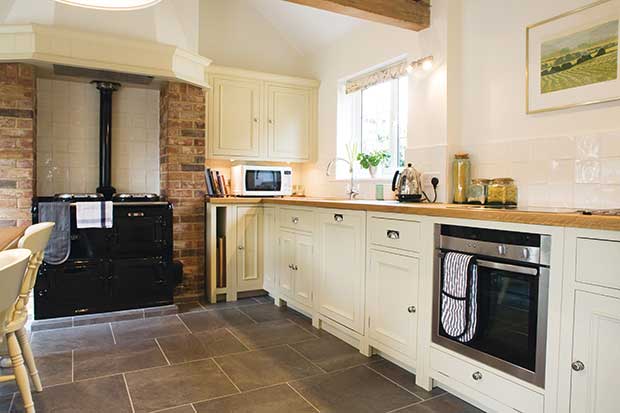
Kitchens for Old Homes
Fitting a new kitchen in an old home requires proper planning and consideration of styles. Natasha Brinsmead explains the key issues

The quirky nature of old houses is what attracts most buyers to them, but it can also present the owners with a few problems with installations. Here, we explore some of the design dilemmas often faced by renovators when it comes to their new kitchen.
Uneven Floors and Walls
Nothing in old homes is perfectly straight and the floors and walls are no exception. This may add a bit of rustic charm in some rooms of the house, but a useful kitchen benefits from level surfaces.

Chichester Country Kitchen from Kit Stone
Floors
When it comes to floors, there are two approaches you can take:
- Level the floor before fitting the kitchen. Floor levelling compounds are liquid bases that flow to the low areas and fill them in. They take 24 to 48 hours to dry, and tiles can be installed on top. The downside is that this will raise the level of the finished floor.
- Use mortar to ensure that the tiles are laid evenly. Mortar is spread over the substrate as usual, but a second application is then spread over the back of the tiles, with extra mortar being placed to target the low spots.
In an old house the floor may never be completely level. It may be necessary to use plastic shims or packers to level the units out. Some kitchens come with adjustable feet, or you could buy some to fit to the underside of base units.
Walls
Tiling an uneven wall can leave an unsatisfactory finish. You could have the wall replastered, although where walls are bowed, you will still be left with a bit of a problem. In this case, you could try using wedges behind the walls. For ease, you could choose not to tile bowed sections of the wall and paint them instead.

This Milton painted kitchen from Second Nature combines classic cabinetry with sleek appliances
Traditional or Contemporary Style
Although the temptation is to remain with the overall style of the house, period homes are not restricted to period-style kitchens. In fact, pairing a more contemporary style kitchen with an older property often highlights the period charm, acting as a nice contrast.
The key to getting this blend right is to make sure that the two styles work together rather than clashing:
- Include warmer, more classic details in order to tie the two styles together, such as marble or timber worktops, an antique-style light fitting or perhaps column radiators.
- Keep any period features intact (eg windows and mouldings). Choose colours that will stand the test of time.
- If you choose a classic unit style, such as a Shaker design, play around with details to update it, perhaps topping it with a modern worktop in places or adding some updated handles, a statement extractor or steel appliances.
Freestanding?
Sales of unfitted, freestanding kitchen furniture have been on the rise in recent years, with many people recognising the flexibility, charm and more individual nature. It works well in period kitchens with uneven walls or a lack of wall space for a run of cabinets.
Pair dressers, freestanding cabinets, plate racks, shelving, and a butcher’s block from various sources and eras for an eclectic look. This can be combined with fitted furniture, such as an island, too.

Fired Earth’s Bastide Freestanding range lends an eclectic charm
Awkward Windows
In cottages and some older period homes, windows were rarely of a standard size, and you often find that windows are lower than the standard height of a kitchen unit. If you have this problem, other than not placing units on the window wall, there are several options:
- Build the units and worktops right in front of the window. On the upside, this will probably be the cheapest option, but on the downside, it could well look like it was the cheapest option, too. Plus, from the outside it might look odd.
- Place a lower height cabinet in front of it and use it for storage. This can still work in a run of units, with the higher cabinets just continuing on either side.
- Use the area in front of the window for a low level dining/breakfast area.
Getting the Steam Out
Your kitchen will require some form of extractor hood to deal with cooking smells and steam. A model that recirculates the air through a filter (that will need to be changed or cleaned) is a simple retrofit option, but many people prefer the extraction method. An extraction hood needs to be ducted to outside. If the hood is to be situated on an external wall, things will be pretty straightforward. However, if you want a freestanding island style hood, or layout doesn’t allow for the hood to be located on an external wall, you will either have to consider boxing in ducting or consider building in a false ceiling to conceal the pipework.